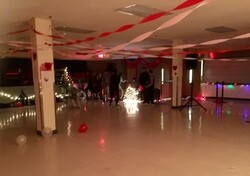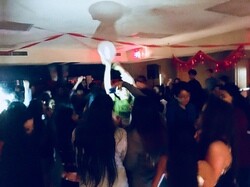
As Valentine’s Day approaches this year, I want to share my favorite school experience with this holiday—a story that showed me the power of student leadership.
When I took on the position of coordinating our Middle School Student Council for the first time last year, I was very excited about creating a space to empower students; I was much less excited about the event planning that had traditionally been a part of the group’s responsibilities. When it comes to events, so many details and so little time so often lead to headaches and exhaustion for the adults in charge.
However, stepping up to our first major endeavor as a student council organization, a Valentine’s Day dance (their choice, not mine!), I began to see things differently. Not only did students demonstrate how capable they were in leading the event, but also the outcome was more energetic and inclusive than I typically see for a middle school dance—and I’m certain that this is because we used democratic processes to make decisions and let students take responsibility for nearly every aspect of the project.
Structuring Middle School Student Council
The council was made up of a representative from each advisory in grades six through eight, nominated through a vote by the members of that advisory. Additionally, 8th graders elected a Student Council President, 7th graders elected a Vice President, and 6th graders voted in one of their classmates to serve as Secretary. It made for about 16 students on the Council when everyone was present. A colleague and I led it together, and we met with the group once every other week during lunch. (We were each paid a stipend for the role.) It took us a while to get it all off the ground, so we had our first actual meeting in December.
At our first meeting, we created norms for the group, using an adapted version of a protocol that we also use in our advisory groups as well as in our teacher-led PLC’s. The norms they came up with are as follows:
- One mic
- No doing homework during meetings—be present
- Bring up serious ideas & topics
- Take others’ ideas seriously—don’t laugh at people’s ideas
- Argue respectfully
- Final decisions should be agreed upon—by majority
- Share meeting “minutes” or announcements with advisor/homeroom;
- Officers present progress update to middle school teachers at the start of our monthly PLC meeting and answer questions
Next, we brainstormed all of the initiatives they were interested in doing this year. It was a long list and included some unrealistic things like shortening the school day or other items that only appealed to a few members. Still, we encouraged students to voice anything and we would prioritize later.
Setting Goals
At our second meeting, we categorized the items on the list. The categories students came up with were (1) fun events, (2) fundraising, and (3) student concerns. We chose two items in each category to attempt that year and then one in each category to begin first. They voted to begin with the following initiatives:
- EVENT: Plan a dance
- FUNDRAISER: Hold a bake sale to raise funds for the dance; proceeds from the dance could be donated to the school’s Angel Fund (for families in need)
- STUDENT CONCERN: the amount of homework middle school students receive—find a way to assess the problem and advocate for change.
A Test of Student Leadership
When I shared with my middle school administrator the ideas students had around a Valentine’s Day Dance, I made it clear I wasn’t going to take over everything to make sure it all happened. I would support and help to fill in gaps that needed adult judgment or communication, but students would need to take the lead.
He was enthusiastic, and noted, “This will be kind of test of their leadership.” It was, and they passed with flying colors!
Here are a few of the things that students did to make this event work:
- They spread the word to their peers. Communications is a profession for a reason, and with an audience of middle school students, it can be uniquely difficult for adults to get them to pay attention to things that are not happening right now. But students spread the word in their own way. They put up signs on their own, they were buzzing about it after our meetings and told their friends, and they posted about it in their Snapchats and other social media. I didn’t lift a finger, except to review the information on their poster.
- They initiated and executed a bake sale in the cafeteria for three days two weeks prior to the dance. I was present, but they notified the lunch staff in advance, made sure classmates brought goodies, ran the sale, and reminded me at lunch on those days to come to the cafeteria to support them.
- With the bake sale funds, they paid for decorations and other accessories for the dance. They asked me to go with them to the Dollar Store in the neighborhood after school (in NYC, this is just a few short blocks away) and I helped make sure they stayed within their budget. They had ideas I wouldn’t have thought of, such as “VIP” wristbands to give out at the door, props and a backdrop for a “Photobooth,” and Christmas tree lights to help transform the cafeteria space.
- Not only did they spread the word to their peers about the dance, but the lead 8th grade event planners also did most of the communicating to other adults in the school. They coordinated with the custodial staff members, who would help move the cafeteria chairs and tables out of the way and adjust the lights. They talked to the office staff to remind them of the details of the event, and checked in with teachers who said they would chaperone to remind them as well. Of course, I also checked in with these adults, but for the most part, students initiated the conversations.
- The officers created a To Do list for the day of the dance.
- Students put up their decorations before the dance.
- One student lent her Polaroid camera and we ordered film (also with bake sale funds) for a photo booth.
- Instead of hiring a DJ, students solicited requests from each advisory and made the play list for the dance based on them. Then two students served as “DJs” during the dance.
- Student Council members stayed after the dance to clean up, which went very quickly.
All of the work and enthusiasm students put into this event considerably alleviated the pressure on my student council partner and me to handle everything. In fact, our main role was making sure the students were making reasonable decisions—they would come to us almost daily to check in about it, and helping them keep track of the progress. We also coordinated with the PTA volunteers who chaperoned and provided pizza and refreshments.
More Fun Than Expected!

The dance itself was a blast. Students took pictures at the photo booth using cool props. There was a ton of dancing, including teachers! There was excellent turnout of students across the three grades, and also across social groups. During the dance, I did not see students standing awkwardly alone—the environment was surprisingly warm and inclusive.
Prior to the dance, we had discussed whether cell phones would be allowed. Since they are not allowed during school hours except with specific teacher permission for educational purposes, we decided not to allow them during the dance. Because the Student Council representatives were leading, they spread this message in advance. We had to verbally remind students a few times, but it did not become an issue. A few council members were allowed to use the cameras on their phones to document the event, and shared these photos with students later. This seemed to work well, and I think it helped students be more present and engaged during the event.
I got to learn a lesson that never gets old: student empowerment is a game-changer. If we provide structure and support for students to raise their voices and take action, they can astonish us with their capacity—and show us a good time!
[Photos taken by author]